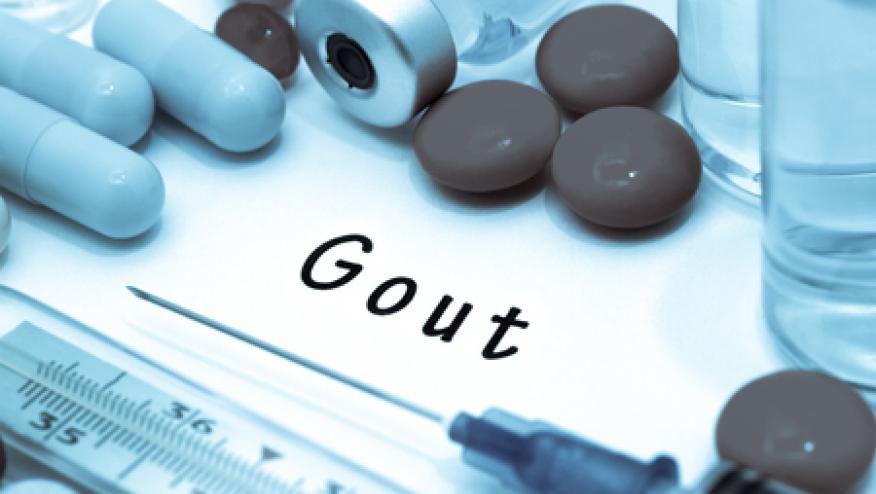Combo Therapy Boosts Response in Uncontrolled Gout Save

The addition of an immunomodulating agent to pegloticase (Krystexxa) among patients with uncontrolled gout significantly improved response rates, a systematic literature review found.
In a cohort of patients whose gout had been refractory to conventional therapy, co-treatment with pegloticase plus an immunomodulator was associated with an overall response rate of 82.9%, reported Robert T. Keenan, MD, of Duke University in Durham, North Carolina, and colleagues.
That rate was "markedly higher" than the 42% that had been observed for pegloticase monotherapy in clinical trials, Keenan and co-authors noted in their study online in Seminars in Arthritis & Rheumatism.
Pegloticase is approved for patients with chronic gout who have inadequate serum urate control with xanthine oxidase inhibitors at the highest medically appropriate dose or in whom these drugs are contraindicated.
Pegloticase differs from other gout drugs in its mechanism of action -- i.e., the conversion of urate to water-soluble allantoin, which can readily undergo renal excretion. With pegloticase, the uricase enzyme is attached to polyethylene glycol in order to decrease immunogenicity and increase the therapeutic half-life.
The development of anti-drug antibodies has been problematic for many biologics such as infliximab and adalimumab used for autoimmune conditions including rheumatoid arthritis and inflammatory bowel disease, leading to loss of therapeutic response and cessation of therapy, the researchers explained. Studies have shown that the addition of conventional immunomodulating agents such as methotrexate and azathioprine to biologic therapy in these conditions can minimize the development of anti-drug antibodies.
Because pegloticase is also a biologic, investigators have been considering the possibility that such an approach might be helpful for refractory gout.
"By virtue of its FDA indication, pegloticase is often administered as a 'last-hope' medication for individuals with severe gout who have failed traditional therapies. In that setting, a failure of pegloticase can heavily impact a patient's well-being and long-term morbidities," Keenan and colleagues wrote.
"Analogous to other biologics, some physicians have begun to try immunomodulation prior to and/or in conjunction with pegloticase in patients with uncontrolled gout, with the goal of minimizing anti-drug antibodies and increasing the number of patients who fully benefit from pegloticase therapy," the team explained.
A co-prescription analysis in the U.S. found that the concomitant use of pegloticase plus an immunomodulator rose from 1% in 2016 to 15% in 2019.
Therefore, to evaluate the data on response rates for immunomodulator use in conjunction with pegloticase so far, Keenan and co-authors conducted a literature review that identified 82 cases from 10 publications.
Half of the patients had been treated with methotrexate, another third with azathioprine, and the remaining patients had leflunomide, mycophenolate mofetil (Cellcept), or cyclosporin.
In the majority of cases, the immunomodulator was initiated before the first infusion of pegloticase, although in a few cases the immunomodulator was started at the same time or later, the investigators noted.
The highest response rate was seen with methotrexate, at 87.5%. Oral methotrexate in dosages of 12.5 to 15 mg/week was associated with a responder rate of 90.3%, while the subcutaneous formulation in dosages of 25 mg/week had a responder rate of 77.8%.
More than three-quarters of patients receiving oral methotrexate began the drug before starting pegloticase, and 87.5% of those who started methotrexate before the biologic were responders. Patients who started the oral methotrexate at the same time as pegloticase or later also were considered treatment responders.
Patients given immunomodulation with mycophenolate mofetil (1 g twice/day for the first 12 weeks in a randomized clinical trial) in addition to pegloticase had a response rate of 86.4% at week 12 and 68% at week 24, compared with 40% and 30%, respectively, with pegloticase monotherapy.
Patients who received immunomodulation with azathioprine (50 to 100 mg or 1.25 to 2.5 mg/kg/day) beginning 2 weeks before the first pegloticase infusion had response rates of 63.6%. For those given leflunomide (10 to 20 mg/day, begun between 7 months before to 6 months after starting pegloticase), the response rate was 66.7%, and the sole patient given cyclosporin (100 mg/day, starting the same day as pegloticase) also was considered a responder.
"Our preliminary findings suggest that a variety of immunomodulatory agents are effective in improving responder rates, which would allow physicians flexibility to use the immunomodulator best suited for each patient," the researchers wrote.
"In summary, among currently available data, combination therapy markedly increased overall pegloticase responder rate, presumably through anti-drug antibody attenuation," Keenan and co-authors concluded, noting, however, that larger randomized trials will be needed to confirm the results.
A limitation of the study, the team said, was the possibility of publication bias.









If you are a health practitioner, you may Login/Register to comment.
Due to the nature of these comment forums, only health practitioners are allowed to comment at this time.